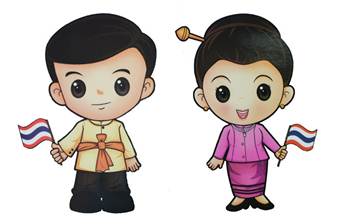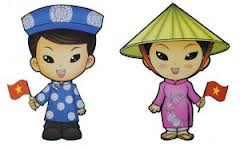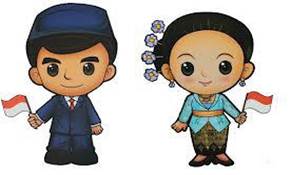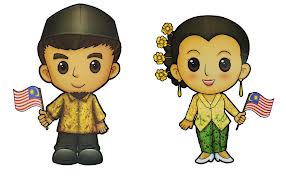Module 2: Awareness of ASEAN Cultures
Table of Contents
Reading Text & Presentation
2.1 Cultural awareness
2.1.1 Cultural awareness in Thailand
2.1.2 Cultural awareness in Vietnam
2.1.3 Cultural awareness in Laos
2.1.4 Cultural awareness in Cambodia
2.1.5 Cultural awareness in Myanmar
2.1.6 Cultural awareness in Indonesia
2.1.7 Cultural awareness in Singapore
2.1.8 Cultural awareness in Brunei
2.1.9 Cultural awareness in Malaysia
2.1.10 Cultural awareness in the Philippines
Table: Similarities and differences in ASEAN cultures
2.1.1 Cultural awareness in Thailand
 Greeting
Greeting
Thai society is very hierarchical and Thais greet each other with a wai rather than a handshake.
Tradition
Do in Thailand:
Thais respect hierarchical relationships. Social relationships are defined as one person being superior to the other. Parents of course are superior to their children, teachers to their students, and bosses to their subordinates.
Don’t in Thailand:
- The head is considered the most respected part of the body and you should avoid touching a Thai person on the head.
- The feet are considered the lowest and dirtiest part of the body. You should avoid pointing your feet at a Thai person. Avoid using your feet to point at things or move things.
- Do not step over a Thai person, rather walk around them.
Thai personalities
Thai people are generally very polite and respectful.
Thai people are very religious, about 95% of Thai people are Buddhists and Thai people believe that making merit in this life will benefit a future life.
Warnings
Thai people are very conscious of “Face”. This cultural trait manifests itself in many ways. Thai people are non-confrontational and losing one’s temper is considered a sign of weakness and a loss of face.
2.1.2 Cultural awareness in Vietnam
 Greeting
Greeting
The Vietnamese generally shake hands both when greeting and when saying goodbye. Shake with both hands, and bow your head slightly to show respect.
Tradition
Do in Vietnam:
- Vietnamese must consider many things in communication and conversation for example, children are taught to think deeply before they speak and they have to have eye contact while communicating.
- A smile is appropriate as a response to an expression such as “Thank you.” or “I am sorry.” and then the recipient will acknowledge it with a smile as well.
- Silence is also common in meetings where someone disagrees with another, but remains quiet so as to not cause loss of face.
- As with most group-orientated societies there are also hierarchical structures. In Vietnam these are very much based upon age and status. An obvious example is seen in social situations where the oldest person in a group is greeted or served first.
Don’t in Vietnam:
- Disagreeing with an authoritative speaker is considered the same as challenging the senior person’s social status.
- Touching children on the head is done by parents, grandparents only. Don’t do it if you are not in the family.
Vietnamese personalities
Vietnamese have a deep sense of national pride, value their independence and history, and are offended by people who ignore or violate either.
They believe all past hostilities were part of the natural defense of their national territory.
They love their family as families are very strong and help each other in all needs.
(Source: http://www.health.state.mn.us/divs/idepc/refugee/globalbbviet.pdf retrieved 30/1/2014)
2.1.3 Cultural awareness in Laos
 Greeting
Greeting
Laotians traditionally greet others by pressing their palms together in a sort of prayer gesture known as a nop and say “Sabai dee.”
Tradition
Do in Laos:
- Lao people have a simple life. They are brought up in extended families that require a high level of harmony, kindness, patience and readiness to help each other.
- It is perfectly normal for relatives or friends to drop by without calling in advance.
- Lao people typically socialize as families, and most live in extended families with three or sometimes more generations sharing one house or compound. The family cooks and eats together sitting on the floor with sticky rice and dishes shared by all.
- Sometimes when someone pays a visit unexpectedly at meal time they are automatically invited to join without any hesitation.
- Before entering a Lao person’s home, take your shoes off and leave them outside the house or on stairs.
Don’t in Laos:
- Time is also a fairly flexible commodity in Lao culture so don’t expect them to be on time.
- The head is considered high. It is not acceptable to touch Lao people’s heads, so bear that in mind.
- Feet are low. Placing them on furniture or pointing at things or people with your feet is not acceptable.
- Personal cleanliness is valued highly in Laos. Anyone who has strong body odor tends to get disgusting looks.
Laotian personalities
Laotians are generous, kind and soft-hearted, tolerant and social people.
(Source: http://www.laos-guide-999.com/Laos-culture.html retrieved 30/1/2014)
2.1.4 Cultural awareness in Cambodia
 Greeting
Greeting
Greetings between Cambodians are dependent on the relationship/hierarchy/age between the people. The traditional greeting is a bow combined with a bringing of the hands together at chest level. It is known as the 'Sampeah'. Where you join your hands at the level of your chest, chin, nose, eyebrows or over the head indicates how highly you respect the person.
(Source: http://www.camboguide.com/cambodia-culture/customs/meeting-greeting-cambodia retrieved 30/1/2014)
Tradition
Do in Cambodia:
- The majority of Cambodians follow Theravada Buddhism. Buddhism also reinforces a sense of hierarchy within society. Interpersonal communication is built on the relationship between those involved including communication depending on your status.
- Common hierarchical guidelines are that parents are superior to children, teachers to students and managers to subordinates.
- Monks will even walk in rank order, highest in front and most junior at the rear.
- It is polite to remove your shoes before entering someone’s house and obligatory in a temple.
Don’t in Cambodia:
- The concept of face also ties in with this collective outlook. Protecting both one's own and another's face is extremely important.
- Face is lost when someone is criticized, embarrassed or exposed in public. It can be given by complimenting someone publicly; so don’t do that to them.
- It is not considered polite to point your feet at anyone and especially not at a Buddha statue or a monk.
- If entering a temple, ensure that you sit cross-legged to avoid offence.
Cambodian personalities
Cambodians are an extremely hospitable and friendly people.
(Source: http://www.kwintessential.co.uk/resources/global-etiquette/cambodia.html retrieved 30/1/2014)
2.1.5 Cultural awareness in Myanmar
 Greeting
Greeting
‘Mingalarbar.’, literally means ‘Hello.’ and can be used at any part of the day. The originally western custom of shaking hands when introduced has become something of a vogue among urbanized Myanma. But this applies only to men. If you were introduced to monks, you would bow or bring your palms together. If you, a man, are introduced to a Myanmar lady, you should not stretch out your hand to shake hers unless she does so first.
(Source: http://www.journeysmyanmar.com/do_and_dont.htm retrieved 30/1/2014)
Tradition
Do in Myanmar:
- Buddhism is at the heart of Myanma culture and it permeates private and public life. Most young people spend time in monastic education, and monks and nuns hold a revered place in society; so they should not be touched; they always sit at the highest place available or the places reserved for them.
- For dress code, revealing clothing is sometimes frowned upon, although it is increasingly common amongst Myanma women. But at religious sites, legs and shoulders should always be covered.
- Shoes and socks should be removed before entering anywhere; pagoda or home.
Don’t in Myanmar:
- The head and feet are important in Myanma culture, as the highest and lowest points of the body. No one, including children, should be touched on the head.
- Feet should never be put on tables or used for touching or pointing.
- Time is flexible here; so you may have to wait longer to be served and signs of impatience will not be taken well.
Myanma personalities
Life in Myanmar exists at a very different pace than it does in most developed countries; people are usually in much less of a hurry, and are more likely to stop to help.
(Source: http://www.go-myanmar.com/cultural-differences-and-adapting-to-life-in-myanmar retrieved 30//1/2014)
2.1.6 Cultural awareness in Indonesia
 Background
Background
There are many cultural influences stemming back from difference in heritage. Indonesians are a mix of Chinese, European, Indian, and Malay. Although Indonesia has the largest Muslim population in the world it also has a large number of Christian Protestants, Catholics, Hindus and Buddhists. This great diversity has needed a great deal of attention from the government to maintain cohesion. So, the national motto is "Unity in Diversity".
Greetings
Shake hands and give a slight nod when meeting for the first time. After the first meeting, a handshake is not necessary; a slight bow or nod of the head is sufficient. Shake an Indonesian woman's hand only if she initiates the greeting with saying "Selamat." which means peace. Say it slowly and sincerely.
Tradition
Do in Indonesia:
- The family is still very traditional in structure. Family members have clearly defined roles and a great sense of interdependence.
- Respect is usually shown to those with status, power, position, and age.
- Point with your thumb, not your index finger. Never beckon with one finger.
Don’t in Indonesia:
- A man does not touch a woman in public except to shake hands. Do not display affection in public.
- The head is considered sacred. Do not touch a person’s head.
- Keep both feet on the floor when sitting.
- Do not cross your legs, and sit with both feet on the floor.
- Do not allow the bottom of your feet to face or point at another person.
- Looking someone straight in the eyes is considered staring, which means challenge and may cause anger.
- Women should wear polite skirts and blouses or dresses according to Muslim rules.
Indonesian personalities
Indonesians value loyalty to family and friends above all else. People are very careful how they interact and speak.
Warning: The strange thing in Indonesia is that Bahasa Indonesian actually has 12 ways of saying "No." and several other ways of saying "Yes." when the actual meaning is "No."!
(Source: http://www.kwintessential.co.uk retrieved 30/1/2014)
2.1.7 Cultural awareness in Singapore
 Background
Background
Singapore is a unique cultural mix of Chinese (76%), Malay (15%) and Indian (6%); so we can assume that Singapore is a multicultural society, but it still maintains certain conventions that must be abided by out of respect for others.
Greetings
Singaporeans shake hands with everyone present at a business meeting or social occasion, and also when leaving. Singaporeans may bow slightly as they shake your hand especially with elders.
(Source: http://www.ediplomat.com/np/cultural_etiquette/ce_sg.htm retrieved 30/1/2014)
Tradition
Do in Singapore:
- Singaporeans always arrive on time for a business meeting and lateness is regarded as disrespectful. Many people take offence at poor timekeeping skills.
- At the beginning and end of the meeting, shake hands with everyone present. It is also polite to give a small bow or nod of your head at this point, particularly towards Chinese or older people.
Don’t in Singapore:
- Singaporeans tend to avoid small talk at the beginning of meetings, instead commencing with business talk immediately. The business environment in Singapore is much more fast-paced than in other cultures; therefore decisions can be reached quite swiftly in many instances.
- Saving ‘face’ in Singaporean culture is critical; so do not cause embarrassment to other persons in a business meeting.
- The foot is considered the lowest part of the body, and is thought to be unclean. The foot should never be used to point at someone, and you should never show the bottom of your feet.
- Never touch a person or child's head. The head is considered sacred.
Singaporean personalities
Singaporean people are described as peaceful, open-minded, and unified, and are accepting of many different cultures meeting, either by disagreeing with them or correcting them.
(Source: http://www.findemployment.asia/relocating-to-asia/cultural-awareness-in-singapore retrieved 30/1/2014)
2.1.8 Cultural awareness in Brunei
 Greetings
Greetings
Handshakes in greeting tend to be light. Bruneian men often raise their hands to the heart after shaking hands. Most Bruneians do not shake hands with the opposite sex.
Tradition
Do in Brunei:
- The family is the focal point of the social structure. The Bruneian family is the extended family. Members of the extended family are expected to remain loyal to each other and the family.
- Age is matter here. Children are taught to subjugate their own desires for the good of the entire family and to respect elders without question.
- Gender relations are also governed by Islamic principles and etiquette.
- Communication style is very indirect.
Don’t in Brunei:
- It is considered disrespectful and rude to stare into another person's eyes, particularly those of a person who is senior to you in age or status.
- The role of face, shame and honor is crucial to Bruneians. Do not cause issues or problems which could jeopardize this.
- Most Bruneians are Muslims and as such their lives revolve around the duties afforded to them by Islam. Alcohol and pork are banned from the country; however, pork is allowed for non-Muslims.
- Shaking hands across genders is rare.
Bruneian personalities
They are very polite and well-mannered.
Punctuality is not strictly adhered to. You may arrive a little late without causing offense.
(Source: http://www.kwintessential.co.uk/resources/global-etiquette/brunei.html retrieved 30/1/2014)
2.1.9 Cultural awareness in Malaysia
 Background
Background
Malaysia is a multi-cultural society. The main ethnic groups are the native Malays as well as large populations of Chinese, and Indians. When visiting the country it is clear that the ethnicities retain their religions, customs and way of life. Although children are educated in the same schools when growing up, and will eventually work in the same offices, few marry outside their own ethnicity.
Greetings
Shake hands with men at business meetings and social events. Shake hands again when leaving. Nod or give a slight bow when greeting a woman or an older person. Introduce higher ranking people or older people first. Introduce women before men. Western women should greet Malay men with a nod of their head and a smile.
(Source: http://www.ediplomat.com/np/cultural_etiquette/ce_my.htm retrieved 30/1/2014)
Tradition
Do in Malaysia:
- The family is considered the centre of the social structure. As a result there is a great emphasis on unity, loyalty and respect for the elderly.
- Families tend to socialise within their own ethnic group – all part of retaining their individual traditions and lifestyles.
- Despite the ethnic differences there are commonalities culturally speaking. Face is a personal concept that embraces qualities such as a good name, good character, and being held in esteem by one's peers.
- Malaysians rely on non-verbal communication (i.e. facial expressions, tone of voice, body language, etc.)
- Remaining calm and courteous; discussing errors or transgressions in private; speaking about problems without blaming anyone; using non-verbal communication to say "No."; and allowing the other person to get out of the situation with their pride intact are all common practices.
Don’t in Malaysia:
- The main thing about people in Malaysia--Malays, Chinese and Indians, is about face losing so when we talk about “don’t” in Malaysian culture, we have to think about this issue and not make them feel ashamed in public or private. The desire to maintain face makes Malaysians strive for harmonious relationships. Face can be lost openly because of the following: criticizing, insulting, putting someone on the spot, doing something that brings shame to the group, challenging someone in authority (especially if this is done in public), showing anger at another person, refusing a request, not keeping a promise, and disagreeing with someone publicly.
Therefore, don’t do as stated above to people in Malaysia. - Never touch anyone on the top of the head (home of the soul), especially a child.
- Avoid touching anyone of the opposite sex. Affection is not shown in public.
- Do not move objects with your feet or point at another person with your foot.
- It is impolite to beckon adults.
Malaysian personalities
Malays are proud of their country and their ancestral background.
They are polite and they will give a slight bow when leaving, entering or passing by people, which means, "Excuse me."
Warning
Malaysians rely on non-verbal communication (i.e. facial expressions, tone of voice, body language, etc.) Such a communication style tends to be subtle and indirect. Malays may hint at a point rather than making a direct statement, since that might cause the other person to lose face. Rather than say "No.", they might say, "I will try.", or "I’ll see what I can do."
(Source: http://www.kwintessential.co.uk/resources/global-etiquette/malaysia.html retrieved 30/1/2014)
2.1.10 Cultural awareness in the Philippines

Background
The Philippines was first settled by Melanesians; today, although few in numbers, they preserve a very traditional way of life and culture. After them, the Austronesians or more specifically, Malayo-Polynesians, arrived on the islands. Today the Austronesian culture is very evident in the ethnicity, language, food, dance and almost every aspect of the culture. These Austronesians engaged in trading with China, India, Japan, the Ryukyu Islands, the Middle East, Borneo, and other places. As a result, those cultures have also left a mark on Filipino culture. Mexican and Spanish influence can be seen in dance and religion as well as many other aspects of the culture. After being colonized by Spain, the Philippines became a U.S. territory for about 40 years. Influence from the United States is seen in the wide use of the English language, and the modern pop culture.
Greetings
A handshake is standard greeting between both sexes; however, a man should wait for a woman to extend her hand before initiating the handshake. However, for informal style an "Eyebrow flash" or a quick lifting of eyebrows is a Filipino greeting.
(Source: http://www.ediplomat.com/np/cultural_etiquette/ce_ph.htm retrieved 30/1/2014)
Tradition
Do in the Philippines:
- The family is the center of the social structure and includes the nuclear family, aunts, uncles, grandparents, cousins and honorary relations such as godparents, sponsors, and close family friends. Filipinos believe they must live up to the accepted standards of behavior, and if they fail to do so they bring shame not only upon themselves, but also upon their family.
- Time considerations are different: it is best to arrive 15 to 30 minutes later than invited for a large party, but punctuality is expected for a meeting.
- Appointments are required, and should be made 3 to 4 weeks in advance.
- Communication is indirect, truth is diplomatically presented, manner is gentle, and the perception of the recipient is considered in all communications. All communication should be courteous, regardless of its content. The Filipino attempts to please may result in many unfinished projects.
- Filipinos find it difficult to say "No.", disagree, reject or be confrontational, especially when a superior is involved. Expect an ambiguous or indirect answer — not to deceive, but rather to please and avoid confrontation.
- Face-to-face meetings are preferred. Written communications might not be answered.
Don’t in the Philippines:
- Staring is considered rude, and could be misinterpreted as a challenge, but Filipinos may stare or even touch foreigners, especially in areas where foreigners are rarely seen.
- Do not stand with your hands on your hips because to Filipinos it means you are angry.
- Never curl your index finger back and forth (to beckon). This is an insult.
- Try not to communicate with them by mail or telephone since Filipinos think it is unreliable.
Philippine personalities
Filipinos are casual, fun loving, sensitive and hospitable people. Personal and family honor are stressed, as well as dignity and pride.
(Source: http://www.kwintessential.co.uk/resources/global-etiquette/philippines-country-profile.html retrieved 30/1/2014)
To summarize what they have in common, and how they are different, we can make a table to compare. If it is something they have in common, the symbol P will appear, but what is not related to the cultures in the countries will be shown by the symbol O. However, some will be left empty as they are not mentioned in this module. You may like to search to find more information.
Table: Similarities and differences in ASEAN cultures
|
TH |
KH |
VN |
LA |
MM |
BN |
MY |
PH |
ID |
SG |
1. The head is considered the most respected part of the body. |
P |
P |
P |
P |
P |
P |
P |
|
|
P |
2. The feet are considered the lowest and dirtiest part of the body. |
P |
P |
P |
P |
P |
P |
P |
|
P |
P |
3. People typically socialize as families and family is very important. |
P |
P |
P |
P |
P |
P |
P |
P |
P |
|
4. They respect hierarchical relationships. |
P |
P |
P |
P |
P |
P |
P |
P |
P |
|
5. They take the shoes off and leave them outside or on stairs. |
P |
P |
P |
P |
P |
|
|
|
|
|
6. Time is flexible. |
|
|
|
P |
P |
|
|
|
|
|
7. People are punctual. |
|
|
|
|
|
|
|
P |
|
P |
8. They bow for greeting. |
O |
P |
O |
O |
O |
O |
O |
O |
O |
P |
9. They shake hands for greeting. |
O |
O |
P |
O |
P |
P |
P |
P |
P |
P |
10. They put the palms together at chest level or in front of the face. |
P |
P |
O |
P |
O |
O |
O |
O |
O |
O |
11. Opposite sexes cannot touch each other in public. |
|
|
P |
P |
P |
P |
P |
P |
P |
|
The abbreviation of the countries in the table are as follows: |